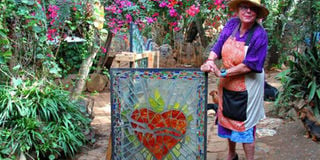Hanging out carefully with Nani Croze

Nani and a stained glass panel for a church in Arusha. PHOTO | JOHN FOX
What you need to know:
- Someone told me that one of her stained glass panels — perhaps the biggest and the best — is in the lobby of the International Casino on Museum Hill, Nairobi. And if you have driven on the new bypass at Museum Hill, you will know that the Casino has been sort of derelict for some time now.
- It is a wonderful piece of work. It is called “Leopardscape” and, at 10 metres by 3 metres, it was the largest stained glass mural in East Africa when Nani completed it in July 1988 — it most likely still is.
Oh dear! Where to start? This is going to be about Nani Croze — and, after an hour or so with her at Kitengela Glass, you can’t but be enthralled by her stories, her art, and her place.
But let me begin with the reason for the latest encounter with this remarkable woman. Someone told me that one of her stained glass panels — perhaps the biggest and the best — is in the lobby of the International Casino on Museum Hill, Nairobi. And if you have driven on the new bypass at Museum Hill, you will know that the Casino has been sort of derelict for some time now.
So I went along to find out what had happened to Nani’s panel. It is still there, straight ahead and up from the entrance. The caretaker was very helpful; he switched on the lights that illuminate the panel from behind — well, two of the three lights were still working.
It is a wonderful piece of work. It is called “Leopardscape” and, at 10 metres by 3 metres, it was the largest stained glass mural in East Africa when Nani completed it in July 1988 — it most likely still is. Nani spent two whole years in the making of it; and no doubt many hours of stress. She had to import some of the coloured glass from England, France, Germany and the United States. The lead came from Belgium. And it wasn’t at all easy to find a builder who could fit the long and curved screen in its place at the main entrance.
Finished, it is an amazing celebration of Kenya’s flora and fauna, alive with vibrant colours — even in the half-light of the closed casino’s dusty and un-peopled entrance hall. And what is going to happen to it? Is there a chance that it will be destroyed if the building is eventually pulled down? So I went to talk with Nani about it.
COLLECTING PEOPLE
It’s a bumpy ride to Nani’s place at Kitengela Glass, after you turn left off Magadi Road, just before the township of Ongata Rongai. If you go straight on to Masai Lodge, you can leave your car there and cross to Nani’s by a rope bridge over the gorge. Or you can drive round via the Africa Nazarene University. From there, there are signposts for Kitengela Glass.
Whichever way you choose, you are going to arrive at a place that is more of a Wonderland than Alice found — a collection of weirdly carved rondavels, bizarre sculptures, cluttered but creative work spaces, flowering shrubs, and a menagerie of animals — camels, pigs, goats and more dogs than you can count.
Nani was one of Konrad Lorenz’s ‘goose girls’, who participated in imprinting experiments with goslings. She must have been a prize student, because birds follow her wherever she goes around her compound — especially a crowned crane (attacking any man who comes near) and even a very tame and more accommodating Egyptian vulture.
Nani seems to be a collector of people, too. Last Sunday lunch, as we sat in her lounge with her husband Eric for soup and samosas, we were joined by Darren, a stand-up comedian, magician and puppeteer from Texas, and also Steve, a young organic farming enthusiast (a WWOOF volunteer) from Nevada — who played on his guitar and sang his song about baboons. A magical place. It really is.
But I went to talk to Nani about the stained glass panel at the International Casino. She is certainly concerned about it — about the possibility that it will be destroyed. If she had her way, she would donate it to a place such as the National Museum.
Nani showed me a list of her commissions: hundreds of murals, concrete reliefs, sculptures, and stained glass — for people and places across East Africa. You can find them in hotels and lodges, in churches, in banks, in schools, in embassies and in private homes.
In and around Nairobi, for example, you can see Nani’s work in the screens of the Thorn Tree Café at the Stanley Hotel; windows of the Windsor Golf Hotel and Country Club off Kiambu Road; screens at Village Market in Gigiri; windows and a dragon sculpture at the pool of the Macushla boutique hotel and restaurant in Karen; windows and a ceiling at the Lord Erroll Restaurant in Gigiri; benches and tables in the Arboretum; and the stained glass Stations of the Cross in the Consolata Prayer Garden in Westlands... And these are only a few.
And if you haven’t yet been — and if you have already been many times — take a half day off and go out to Kitengela Glass, where Nani oversees her craft workshops and where she looks after all her animals and birds — and guests. But be wary of the risk of imprinting.




